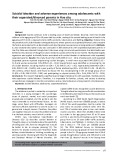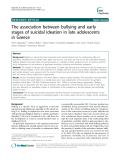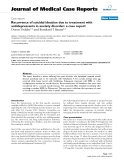
HUE JOURNAL OF MEDICINE AND PHARMACY ISSN 1859-3836 25
Hue Journal of Medicine and Pharmacy, Volume 13, No.6-2023
Suicidal ideation and adverse experiences among adolescents with
their separated/divorced parents in Hue city
Tran Thi Tra My1, Tran Binh Thang1, Nguyen Minh Tam1, Vo Nu Hong Duc1, Nguyen Van Thong1,
Nguyen Ngo Bao Khuyen1, Pham Thị Thu Ha1, Ho Uyen Phuong1, Vo Hoang Linh1, Luong Thi Thu Tham1,
Hoang Tuan Anh1, Dang Cao Khoa1, Nguyen Thanh Gia1, Nguyen Minh Tu1*
(1) Hue University of Medicine and Pharmacy, Hue University
Abstract
Background: Suicide continues to be a leading cause of death worldwide. Recently, more than 45,000
children in the age group of 10 to 19 years died by suicide, making it the second leading cause of death in the
age group of 15 to 19, surpassed only by traffic accidents, tuberculosis, and fighting. Objective: To determine
the prevalence of suicidal ideation among adolescents whose parents are separated/divorced; and to explore
the factors associated with suicidal ideation and describe adverse experiences among adolescents. Methods:
A cross-sectional descriptive study was conducted in 309 adolescents with separated/separated parents in
Hue City. Data was collected through direct interviews using a structured questionnaire. Suicidal ideation was
defined as the presence of thoughts or plans related to suicide within the last 12 months. Multivariate logistic
regression was applied to identify factors associated with suicidal ideation in adolescents with separated/
separated parents. Results: The study found that 15.5% (95% CI:11.7 - 20.1) of adolescents with separated
/separated parents reported experiencing suicidal thoughts, in which men accounted 8.4% (95% CI:5.6 –
11.2) and women accounted 7.1% (95% CI:4.5 - 10.6). Several factors were identified as increasing the risk
of suicidal ideation, including alcohol use (OR = 3.24; 95% CI:1.42 - 7.42), hyperactivity/inattention (OR =
4.96; 95% CI:1.58 - 15.605), and a poor quality of family relationships (OR = 4.82; 95% CI:1.26 - 18.50). On
the contrary, certain factors were found to reduce the risk, including being in the 14-15 age group of 14-
15 (OR = 0.26; 95% CI:0.10 - 0.69) and participating in physical activity (OR = 0.44; 95% CI:0.21 – 0.94).
Conclusions: The research highlights a significant percentage of adolescents with separated / divided parents
who experience suicidal ideation. Therefore, it is imperative for families, schools, and society to develop
comprehensive strategies to monitor and address various risky behaviours among students simultaneously.
Keywords: suicidal ideation, adolescents, separation/divorce.
1. INTRODUCTION
The adolescent period is marked by an important
transition in a young teenager’s life. Accordingly,
issues of physical, mental, and social perception
are gradually completed, and this period is also the
most vulnerable to environmental factors. At this
stage, when faced with difficulties, teenagers do
not have sufficient awareness to see the issues in a
general and in-depth manner. Therefore, they often
use negative measures to solve the problem and see
it as the best solution, one of which is suicide.
WHO’s new International Classification of
Diseases (ICD 11) describes suicidal ideation as
‘thoughts, ideas, or ruminations about the possibility
of ending one’s life, from the thought that it would
be better to die to complex planning’ [1]. The
Centres for Disease Control and Prevention (CDC)
defines suicidal ideation as ‘thinking, considering, or
planning suicide’ [2]. Along with that, the Diagnostic
and Statistical Manual of Mental Disorders, 5th
Update (DSM-5) also recognised suicidal ideation as
‘thoughts about harming yourself with consideration
or deliberately planning techniques that could cause
one’s own death’ [3].
According to a 2019 World Health Organisation
(WHO) report, more than 700,000 people, or about
1.3% of the world population, died by suicide this
year. Every 45 seconds someone takes their life,
and 77% of suicides take place in low- and middle-
income countries. More than 45,000 children died
by suicide in the age group from 10 to 19 years
and this is also the fourth leading cause for the age
group from 15 to 19 years (after traffic accidents,
tuberculosis, and fighting). In Vietnam, the suicide
rate is about 5 - 9.9 cases per 100,000 people
[4]. The 2015 National Survey on Vietnamese
adolescents and young people of more than 10,000
people in the 14 - 25 age group showed that 4.1% of
people thought about suicide, and 25% tried to end
their lives [5]. Research results in Hai Duong show
Corresponding author: Nguyen Minh Tu. Email: nmtu@huemed-univ.edu.vn
Recieved: 24/7/2023; Accepted: 12/12/2023; Published: 31/12/2023
DOI: 10.34071/jmp.2023.6.3

























